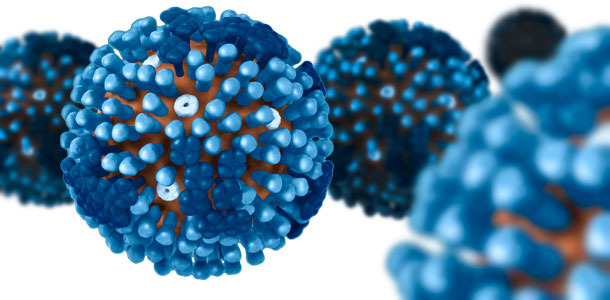Control of influenza infections in swine farms has become more difficult due to the multiple strains and subtypes of influenza virus co-circulating in farms. Influenza infections are self-limiting at the individual animal level with infection lasting between 5 and 7 days approximately. However, infections at the population level tend to persist and can be detected at about any time. Influenza virus is considered endemic in swine populations worldwide, and is not uncommon to find between 3 and 5% of pigs positive to influenza virus at slaughter.
Therefore one of the key questions to understand in influenza infection and transmission is the persistence of the virus at the population level. One answer might be that the individuals within the populations become infected at different time points and/or that some individuals become re-infected with the same virus or different strains throughout the production stage.


3D graphical representation of a generic influenza virion’s ultrastructure. CDC/ Doug Jordan, M.A.
The factors that contribute to virus maintenance at the population level are not fully elucidated. We can speculate of the role of some factors based on field observations. In a recent study, influenza virus could be detected for at least 70 days in a population of weaned pigs where pigs were weaned within a week and no more pigs were introduced after that. Pigs included in this study were selected from a herd with varying vaccination status against Influenza. Based on our experience a pre-farrowing vaccination strategy against Influenza can help to reduce prevalence but does not eliminate completely the virus spread.
At weaning, a variable number, although low of animals tends to be infected. After weaning, and likely associated with the decay of maternal immunity, the influenza virus tends to transmit rapidly and tends to infect each and every animal within the population. In a study conducted at the University of Minnesota, we documented that basically all animals in the population were infected within 3 weeks after weaning and that a prevalence as high as 50% could be reached during the peak of infection. Once the peak of infection was over, prevalence decreased drastically even at levels lower than 2.5% but interestingly, the virus could be found during all weeks. In this study, we also identified a second outbreak at about 7-8 weeks after weaning. The second outbreak was mostly dominated by a virus subtype different from the one that dominated the first outbreak. However, most of the pigs became re-infected despite the fact that all pigs had become infected during the first outbreak.
At a first glance the results of this study suggested that the second outbreak was due to the introduction of a new virus in the population. However, genetic studies using molecular techniques with higher resolution indicated that both viruses were present at weaning but that due to reasons that we are currently investigating, both viruses did not have the same transmission patterns after weaning. Differences in the levels of immunity against each of the viruses or management strategies that perhaps favored one virus versus the other may have played a role how viruses transmitted in this case. Even after the second outbreak, influenza virus could still be detected at prevalence of at least 2.5%.
Given that weaned pigs are housed in pens in contact with each other, it is possible that influenza transmission is continuous. The detection of influenza virus in the nasal cavity indicates presence of the virus but does not indicate active infection. It might be possible that during the acute phase of an outbreak a significant number of pigs go through an active infection, but that when the outbreak is over, the virus may reside in the upper respiratory track of some pigs without causing disease, also likely associated to the presence of immunity.
In summary, infection at the population level in growing pigs tend to be prolonged which indicates that weaned pigs can be a reservoir for other animals and people. All-in/all-out strategies are necessary to prevent the transmission of influenza virus between groups of pigs. It is important to explore and consider strategies to wean influenza free pigs that are immune to the virus at weaning and throughout the growing phase.


